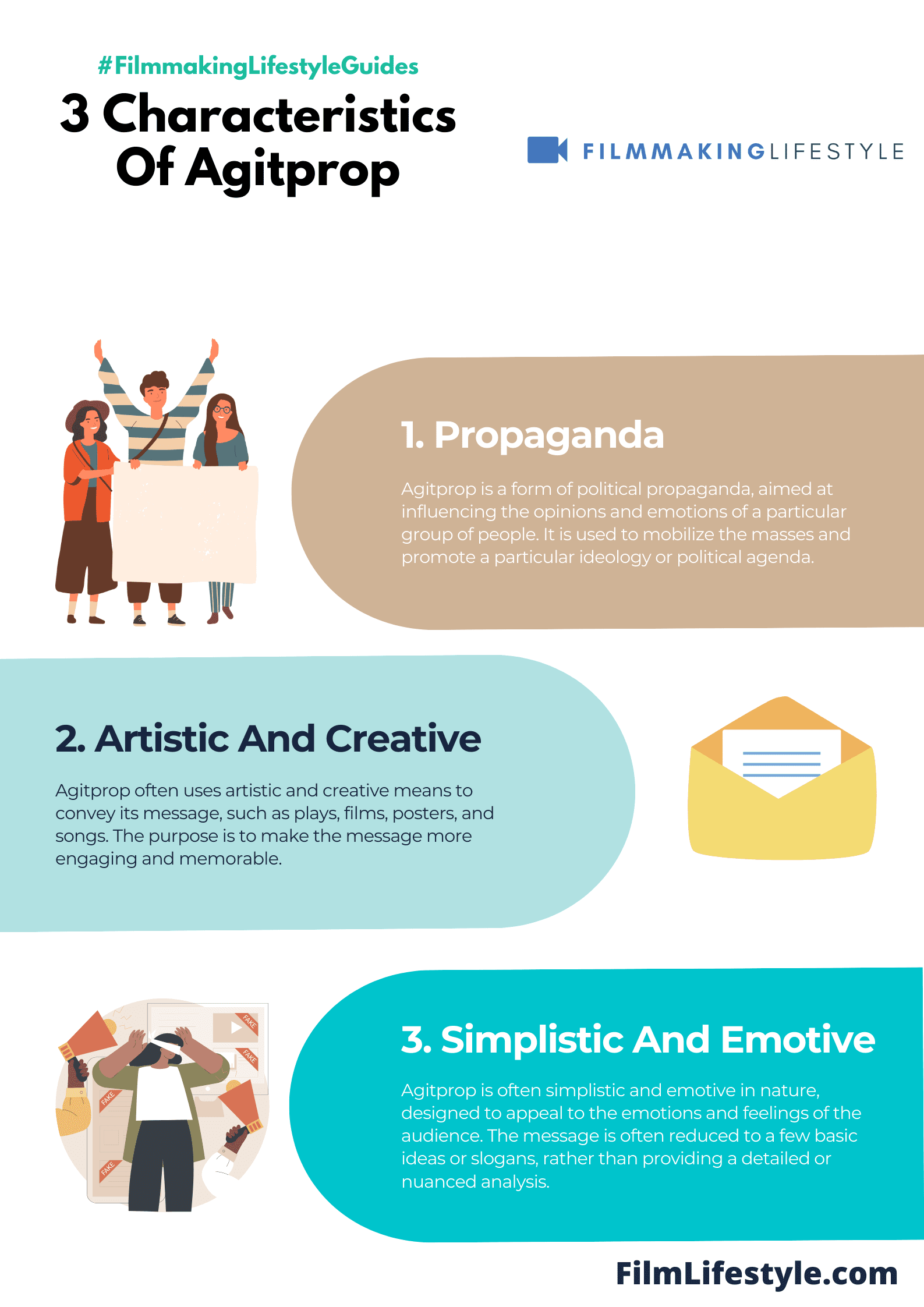Agitprop (from the Russian агитпроп, an abbreviation of agitation and propaganda), or agitprop art, is a style of visual art commonly associated with socialist realism, Soviet propaganda, and communist politics.
Agitprop often has a political purpose: to influence popular opinion and promote leftist ideas.
It is similar to political art in that it must serve a political purpose. Agitprop can be disseminated via print, film, audio, and other media.
The major difference between agitprop and other forms of art is that the latter is concerned with aesthetic issues such as quality.
In theory, agitprop should reflect popular interests; in practice by definition, it must represent the party’s official position. Agitprop is different from propaganda because the latter does not necessarily advocate any particular political view or position.
WHAT IS AGITPROP
What Is Agitprop?
Agitprop, derived from the Russian agitatsiya (agitation) and propaganda, is a political strategy used to achieve a specific purpose.
Agitprop is used in conjunction with Marxist-Leninist philosophy and tactics. Karl Marx used agitprop as a political tool.
As an ideology, it combines political theory with art and literature in an attempt to indoctrinate the masses.
In today’s world, agitprop can be seen in mainstream media outlets, including newspapers, television, and film.
The term has also been applied to advertising campaigns that use shocking imagery in order to get their message across; the idea is that if you can get people riled up, they will act.

Agitprop is a powerful blend of agitation and propaganda, aimed to stir the public towards a specific political cause.

It’s a tool that’s been used throughout history to shape opinions and mobilize movements.
In this article, we’ll unpack the origins of agitprop, explore its impact on society, and discuss its relevance in modern digital era.
Stay with us as we jump into the intriguing realm of political persuasion and its enduring influence.
Origins Of Agitprop
The inception of agitprop is deeply rooted in the tumultuous climate of early 20th-century Russia.
Born amidst the waves of the Bolshevik Revolution, this form of political strategy sought to disseminate the revolutionary message across the vast strata of society.

The term itself emerged as a fusion of the words ‘agitation’ and ‘propaganda,’ each aspect serving its critical function – agitation meant inspiring action, while propaganda aimed to spread ideology.

It was during this period that agitprop turned to the arts as a vehicle for its expression.
Theater troupes, poster art, and film became instrumental in reaching the wider population.

Pioneers like sergei Eisenstein revolutionized the use of cinema with films such as Battleship Potemkin, which harnessed the power of visual storytelling to propagate political ideas.
- Theater – made use of live performances which directly engaged the audience,
- Poster Art – utilized bold imagery and slogans to capture attention and convey a message quickly and effectively,
- Film – combined compelling narratives with innovative cinematography to create an emotional and ideological impact.
also, the state established various agitprop organizations to train artists and intellectuals in the craft of political persuasion.
These entities were fundamental in shaping the strategies and techniques that would be disseminated across and beyond the borders of the Soviet Union.
As agitprop evolved, its reach extended globally, influencing movements and governments worldwide, adapting to the contours of each society’s political landscape.
Impact On Society
Agitprop didn’t just flourish as a tool within boundaries of its Soviet birthplace; it had a reverberating impact on societies worldwide.

Cultural landscapes were forever changed as agitprop-inspired art permeated various movements, prompting people beyond Russian territories to consider art as a vehicle for political activism and societal change.

Across continents, political groups adopted the agitprop approach, harnessing its powerful mix of entertainment and ideology to advance their causes.
Creative expression became a means to an end – not just to showcase beauty or explore aesthetic themes but to mobilize individuals and promote change.
- Art and film,
- Literature and music,
- Live performances and events.
Each served as a conduit for the spread of political messages, often tailored to local issues and resonating deeply with the audience they aimed to influence.
In Western countries, agitprop found its expression in various periods of social upheaval.

The Civil Rights Movement, feminist waves, and protests against the Vietnam War all saw their messages amplified through agitprop’s methodology.

Films like Battleship Potemkin were studied not only for their innovative cinematic techniques but also for their underlying messages, which many activists found relevant to their causes.

also, agitprop also significantly influenced the development of public relations and advertising industries.
The principles of clear messaging and persuasive communication became fundamental in shaping consumer behavior and public opinion.
The legacy of agitprop is evident in the ways commercial entities craft campaigns to achieve maximum impact, a testament to the enduring nature of its strategies.
By understanding agitprop’s far-reaching effects on society, we get a better grasp of its role not only as a historical phenomenon but as a continuing presence in artistic and commercial communication.
The impact remains vivid in the ways we use art to reflect and reshape the world today.
Relevance In The Modern Digital Era
Agitprop’s DNA is interwoven with the fabric of modern digital communications.

We see its descendants in the myriad posts, tweets, and videos that pepper our social media feeds, each one loaded with intent, each one a call to action or a bastion of ideological expression.
As we jump into the fusion of art and messaging in today’s world, it’s clear that the tactics of disseminating influential content have evolved but the core principles remain startlingly consistent with their agitprop origins.
The rise of viral marketing and meme culture underscores the ongoing relevance of agitprop techniques.
Platforms like Twitter, Instagram, and TikTok serve as fertile grounds for the rapid spread of influential messages, encapsulating the marriage of directive content and artistic expression.

Our understanding of these modern platforms gains depth when examined through the agitprop lens, offering insights into how information and aesthetics combine to produce potent narratives:

- Authenticity and emotional appeal drive engagement,
- Clear, concise messaging resonates and persists,
- Visual storytelling, now through videos and infographics, follows agitprop’s legacy.
In film and digital content creation, we appreciate agitprop’s influence in the compelling narratives that not only entertain but inspire social change.

Contemporary examples like The Trial of the Chicago 7 or When They See Us draw lines back to the roots of the agitprop movement, using storytelling to illuminate and persuade.
These productions don’t just recount history; they actively participate in the shaping of public consciousness and discourse, embodying agitprop’s enduring force.
Analyzing digital marketing campaigns, we find agitprop’s echo in the strategic use of impactful imagery and slogans designed to leave a lasting impression and drive consumer behavior.

The principles of creating memorable and persuasive content that were once the purview of political movements now underpin successful campaigns across the commercial realm.
Our iterative approach to content creation and assessment acknowledges the importance of crafting messages that not only inform but also inspire and mobilize.
What Is Agitprop – Wrap Up
We’ve seen agitprop’s enduring impact on modern media and marketing.
Its techniques are alive and well, shaping our digital landscape through powerful narratives and captivating visuals.

As we navigate the constant stream of content, we recognize the agitprop legacy in every viral trend and social media campaign.

Understanding this influence is key to both appreciating the art of persuasive communication and remaining vigilant about the messages we consume.
Let’s carry this awareness into our interactions with the ever-evolving world of digital content.
Frequently Asked Questions
What Is Agitprop?
Agitprop refers to the deliberate spreading of propaganda, especially in the arts, to influence public opinion and incite social change.
How Is Agitprop Relevant In The Digital Era?
In the digital era, agitprop is relevant as it has evolved into viral marketing and meme culture, utilizing platforms like Twitter, Instagram, and TikTok to disseminate persuasive content.
Can Agitprop Principles Be Identified In Modern Marketing?
Yes, modern digital marketing campaigns often use agitprop principles by creating impactful visuals and slogans that aim to reshape consumer behavior.


Does Agitprop Influence Contemporary Film And Digital Content?
Agitprop greatly influences contemporary film and digital content by leveraging compelling narratives to inspire viewers and encourage social or political change.
Why Is Understanding Agitprop’s Influence Important?
Understanding agitprop’s influence is crucial for comprehending its role in shaping artistic and commercial communication in contemporary society.


